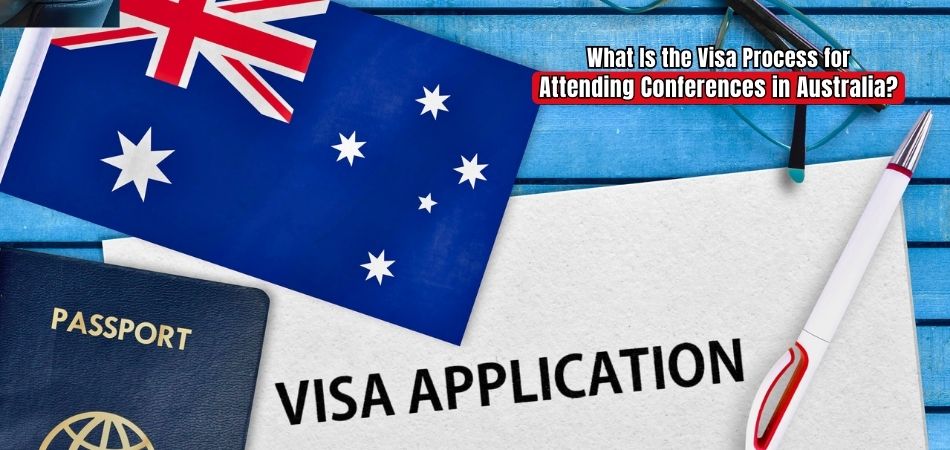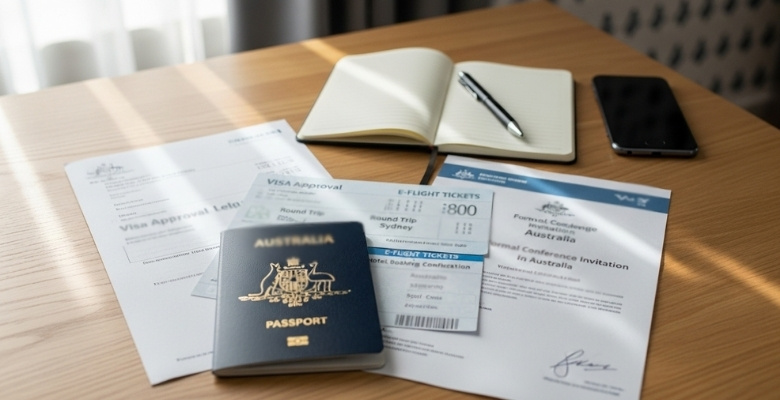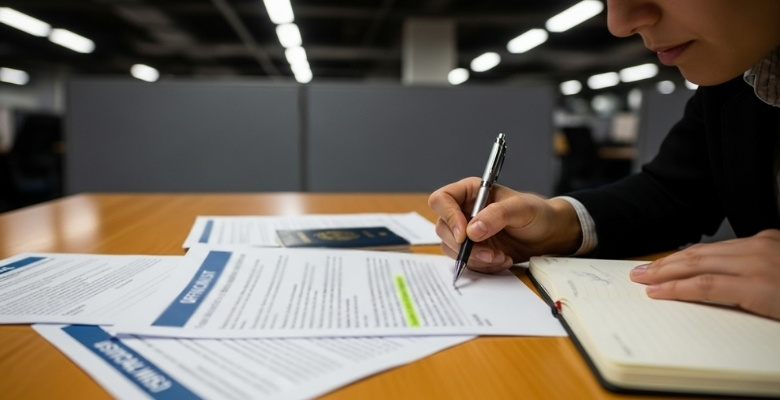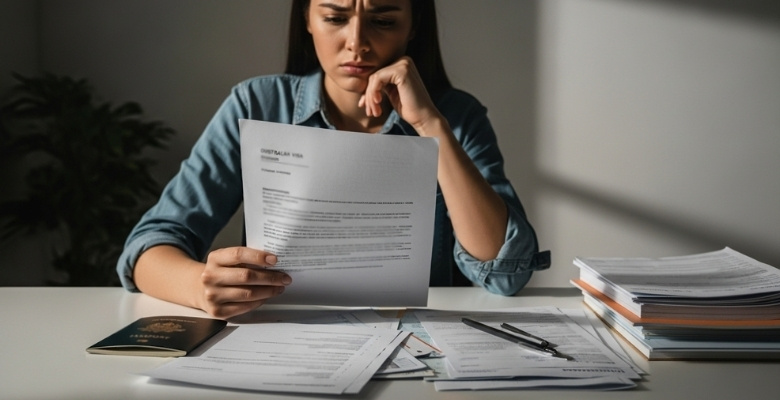Attending conferences in Australia is a great way to connect with experts, explore new ideas, and gain fresh knowledge. But before you think about packing your bag or printing your name badge, you need to handle one important step in the visa process. You’re probably wondering what needs to be done and how it all works. That’s where the question comes in: What is the visa process for attending conferences in Australia?
The visa process for attending a conference in Australia starts with creating an ImmiAccount and choosing the right visa type. Next, complete the application form, pay the fee, and upload your documents. You may also be asked to provide biometrics or health checks. After submission, updates arrive by email, and the visa grant is sent electronically once approved.
Do you want to know how each step actually works and what documents you must prepare? If you are curious about every detail, from fees to possible rejection reasons, keep reading because this article has all the information you will need.
What Is the Visa Process for Attending Conferences in Australia?
Planning to attend a conference in Australia can be exciting, but before you pack your bags, you’ll need the right visa. The process may sound tricky, but it’s actually straightforward if you follow the steps carefully. Let’s break it down together so you can apply with confidence.
Step 1: Create an ImmiAccount
Create an account on the official immigration portal called ImmiAccount. You will use it to start your application, upload documents, pay, and track updates. If you already have an account, just sign in.
Note: if you are eligible for the ETA 601, you apply in the Australian ETA mobile app, not in ImmiAccount.
Step 2: Pick Your Visa
Now that you’re in, the next step is to choose the Australia conference visa for your trip. For conferences, most people apply for the Visitor Visa (subclass 600), ETA (subclass 601), or eVisitor Visa (subclass 651). These visas are designed for business events, seminars, and upcoming international conferences in Australia, making them suitable for short professional visits. Make sure you read the rules for each visa type before applying.
Step 3: Fill the Form
Once you pick your visa, you’ll need to fill out a form with your personal details. You’ll be asked about your passport, travel dates, and conference information. It’s important to answer everything honestly and double-check for spelling mistakes. Wrong or missing info can slow down the process or even cause a rejection.
Step 4: Pay the Fee
After completing your form, you will need to pay a visa application fee. The amount depends on the visa type you selected. You can pay this fee online using a card. Once paid, make sure to save or screenshot your receipt in case you need it later.
Step 5: Upload Documents
Now it’s time to upload the documents needed for your visa. These usually include your passport, conference invitation, proof of funds, travel plan, and accommodation details. Make sure your scans are clear and readable. All documents must match the information you entered in your form.
Step 6: Biometrics and Health
You may be asked to give biometrics like fingerprints or attend a health check in some cases. You’ll get an email if this is required. If it happens, you must visit a nearby center and follow the instructions given. Not everyone needs to do this, but it’s good to be ready. Below is a sample of an email you can get:
Step 7: Wait for Decision
After you submit everything, the only thing left is to wait. You’ll get updates by email, so check your inbox often. Most people hear back in a few days or weeks, depending on the visa and where they applied from. Once approved, your visa will be sent by email, and you’re all set to travel. Below are some sample emails you can get after submitting your applications:
Sample 1: Application Progress Update
Sample 2: Visa Grant Notice
Sample 3: Refusal Notice
Documents Checklist for an Australian Conference Trip
Getting ready for a conference in Australia means more than just booking flights. The visa application asks for certain documents to prove your plans and stability. Having them ready will save you stress and delays. Let’s check them one by one.
- Valid passport
- registration proof
- Conference invitation
- Proof of funds (bank statement, payslips, sponsor letter)
- Accommodation details
- Travel plan
- Return ticket (recommended)
- Proof of ties to the home country
- Travel insurance (optional but highly recommended)
Valid Passport
Your passport is the most important document for your trip. Make sure it is valid on the day you enter Australia and preferably for a few months after. Check that the pages are not damaged and have space for visa stamps. A clear scan of the information page will be needed during the application.
Registration Proof
Conference registration shows that you are actually attending the event. This can be a payment receipt, email confirmation, or event ticket. Keep both digital and printed copies safe for quick use. It helps immigration officers see that your purpose is genuine.
Conference Invitation
An official invitation letter from the event organizer adds strength to your application. It should include your name, event dates, venue, and your role as attendee or speaker. If you don’t have one, politely request it from the organizer. This letter proves your reason for visiting Australia. Here is a sample of a conference invitation letter You can get from the conference organizer:
[Organizer’s Letterhead or Logo]
[Date]To Whom It May Concern,
This is to confirm that [Full Name], holder of passport number [Passport Number], has been invited to attend the [Conference Name]. The event will be held from [Start Date] to [End Date] at [Venue Name, City, Australia].
[Full Name] has registered for this event as a [Attendee/Speaker/Panelist]. The purpose of the conference is to bring together professionals to discuss [Conference Theme/Topic].
We kindly confirm that this invitation is issued only for the purpose of attending the conference. No paid work or employment in Australia is involved.
For any further details, please feel free to contact us:
- Organizer Name: [Name]
- Position: [Title/Role]
- Organization: [Conference Organizer Name]
- Email: [Email Address]
- Phone: [Phone Number]
Sincerely,
[Signature]
[Name of Organizer]
[Title]
[Conference Organizer/Association]
Proof of Funds
Immigration officers want to know you can support yourself during the trip. Bank statements, salary slips, or a sponsorship letter can be used. The documents should clearly show you have enough money for accommodation, food, and travel. This step assures authorities that you will not face difficulties abroad.
Accommodation Details
You need to show where you will stay during the conference. Hotel bookings, Airbnb confirmations, or a host’s invitation letter are all acceptable. Even tentative bookings are fine as long as they show a clear address. This proof adds trust to your travel plan.
Travel Plan
A simple itinerary helps demonstrate your purpose. Mention your arrival date, conference days, and return date. You can also include short notes about sightseeing if planned, but keep it realistic. This shows your stay is focused and limited.
Return Ticket
Having a booked or reserved return ticket is strong proof of your intention to leave. Even if it is a refundable booking, it signals that you are not planning to stay longer. Airlines often allow temporary holds that can be shown in applications. This step reassures immigration officers of your commitment.
Proof of Ties
Showing ties to your home country is key to visa approval. This can be an employer letter, proof of business, study enrollment, or family details. It demonstrates you have responsibilities to return to. Strong ties reduce doubts about overstaying in Australia.
Travel Insurance
While not compulsory, travel insurance is strongly recommended. It covers unexpected medical costs, trip cancellations, or lost luggage. Choosing a policy that covers your entire stay is the safest option. It gives peace of mind to you and also adds strength to your visa application.
Which Visa Do You Need to Attend a Conference in Australia?
If you are planning to attend a conference in Australia, choosing the right visa is an important first step. Different visas apply depending on your nationality, length of stay, and purpose of visit. Picking the correct option avoids delays or problems. Let’s look at the most common choices for conference visitors.
- Visitor Visa (subclass 600 – Business Visitor stream)
- Electronic Travel Authority (subclass 601)
- eVisitor Visa (subclass 651)
Visitor Visa (subclass 600)
Visitor Visa under the Business Visitor stream is often used for short conference visits. It lets you attend events, meetings, and seminars without taking up paid work. This is the required visa for attending a conference in Australia if your passport doesn’t qualify for the ETA or eVisitor visa options. Stays are usually allowed for up to three months, and you’ll need to apply online with supporting documents.
Electronic Travel Authority (subclass 601)
ETA works as a fast and simple option, but it is only available to passport holders from certain countries. It allows multiple entries within 12 months, with each visit lasting up to three months. Application happens online and is usually processed quickly. This visa type is popular for travelers who need flexibility with multiple conference visits.
eVisitor Visa (subclass 651)
eVisitor Visa is designed for citizens of certain European countries. It is free to apply for and works much like the ETA, allowing multiple short stays over a 12-month period. This visa is also applied for online and is processed electronically. It is a practical choice for eligible travelers heading to Australia for conferences or business meetings.
Key Comparisons Between These Visas:
| Visa Type | Who Can Apply | Entry Flexibility | Main Benefit |
| Visitor Visa (subclass 600 – Business Visitor) | Anyone who needs to attend a conference and cannot use ETA or eVisitor | Single or multiple entries, depending on approval | Best for people whose passports are not eligible for ETA or eVisitor, or those needing flexibility |
| Electronic Travel Authority (ETA 601) | Passport holders from specific countries (check eligibility list) | Multiple entries allowed for 12 months | Fast and easy online application for eligible travelers |
| eVisitor Visa (subclass 651) | Citizens of the listed European countries | Multiple entries allowed for 12 months | Free to apply and quick for eligible European travelers |
What You Can and Cannot Do on These Visas?
Attending a conference in Australia is allowed on certain visas, but the rules are very specific. Some activities are permitted, while others are restricted. Knowing both sides will help you use your visa properly. The following is what you can and cannot do with these visas:
Can Do
- Attend Conferences: You are allowed to attend conferences, seminars, and business events as long as they match your visitor visa purpose.
- Join Business Meetings: Meeting with clients, partners, or colleagues for short-term discussions is permitted, provided no paid work is involved.
- Take Short Courses: Study or training is allowed for up to three months, but anything longer requires applying for a student visa.
- Enjoy Tourism: You can explore Australia, visit attractions, shop, or travel around the country during your stay.
Cannot Do
- Take Paid Work: You cannot accept payment or employment from any Australian organization during your stay on these visas.
- Offer Long-Term Services: Working on projects, contracts, or services that replace local jobs is not permitted.
- Stay Indefinitely: These visas only allow short visits, usually up to three months per entry, so overstaying is not allowed.
- Switch Visa Types: You cannot change from a visitor visa to another type while inside Australia; new applications must be made outside.
Breakdown of Australian Visa Costs and Processing Periods
Visa costs and processing times in Australia vary by visa type, passport, and where you apply. Extra service or biometrics fees may apply. Understanding the basics helps you plan well. Keep reading for more details:
Visa cost
- ETA 601: Usually applied online with a small service charge (AUD 20) in some cases. You pay in Australian dollars using a card and get an email receipt.
- eVisitor 651: Often no application charge, but rules can change at any time. Check the official page before you apply and keep a copy of your submission.
- Visitor 600 (Business Visitor): Has a base application fee (AUD 200) shown on the Home Affairs site. Each applicant pays separately, and multiple-entry choices can affect the price.
- Possible extras: Biometrics, health exams, translation, courier, and service center fees may apply. Card surcharges and exchange rates can add a little more to the total.
- Money tips: Use a card that works internationally and save the receipt as a PDF. Do not pay twice if the portal stalls; refresh ImmiAccount later and check the status.
Processing period
- ETA 601: Often very quick, sometimes the same day. Extra checks can push it to a few days.
- eVisitor 651: Usually fast, commonly days rather than weeks. Timing depends on your passport and any extra documents requested.
- Visitor 600 (Business Visitor): Can take weeks, and busy seasons may be longer. Apply early to avoid stress before your conference dates.
- What speeds things up: Complete forms, clear scans, and details that match your passport. Reply quickly to any Home Affairs request.
- How to track: Watch your ImmiAccount for updates and final decisions. Wait for the grant email before buying non-refundable flights or hotels.
How to Improve Your Chances of Visa Approval?
Applying for an Australian visa can feel stressful, but being prepared makes a big difference. A clear and organized application is more likely to succeed. Small mistakes often lead to delays or refusals. Let’s explore simple ways to strengthen your application.
Clear Documents
Submit documents that are easy to read and complete. Blurry scans or missing pages can cause the officer to question your case. Always double-check that every required document is included. Clear paperwork builds trust in your application.
Take Your Time
Rushing through the form often leads to errors. A single wrong detail can delay your approval or even cause a refusal. Set aside enough time to complete each part carefully. Slow and steady applications have fewer problems.
Honest Answers
Every answer you provide must match your supporting documents. Inconsistent or false details will damage your credibility. Immigration officers often verify information across different documents. Being truthful keeps your application strong and reliable.
Proof of Return
Showing that you plan to go back home is very important. Provide a return flight, employer leave letter, or family details. Immigration looks for ties that connect you to your country. Strong proof reduces any doubt about overstaying.
Double-Check Uploads
Before you submit, check that all documents are uploaded correctly. Missing files can hold back your application from moving forward. Review both the form and uploads in ImmiAccount. This final step often avoids unnecessary requests for extra papers.
Stay Consistent
Make sure every detail matches across all documents. Dates, names, and addresses should be the same everywhere. Even small mismatches may create doubt for the officer. Consistency shows that your case is genuine and well-prepared.
Respond Quickly
Sometimes officers request more documents or clarification. Delaying your reply can extend the process or risk rejection. Check your email and ImmiAccount often for updates. Fast responses keep your application moving smoothly. Below is a sample email response to a visa officer:
Subject: Response to Additional Information Request – Visitor Visa
Dear [Visa Officer’s Name or Department of Home Affairs],
Thank you for your email regarding my Visitor Visa application (Application ID: [Your Application Number]). I understand that additional information is required to continue processing my case.
As requested, please find attached the following documents:
- [Document 1, e.g., Updated bank statement – 3 months]
- [Document 2, e.g., Employer leave approval letter]
- [Document 3, e.g., Conference registration confirmation]
All attachments are clear and complete. If further details are required, kindly let me know, and I will provide them immediately.
Thank you for your time and assistance.
Sincerely,
[Your Full Name]
[Your Passport Number]
[Your Contact Number]
[Your Email Address]
What to Do If Your Australian Visa Is Rejected?
Getting a visa rejection can feel disappointing, but it does not mean your plans must end. Every refusal has reasons behind it, and fixing those issues can improve your next try. With the right steps, you can move forward. Let’s see how you can handle this situation carefully.
Rejection Reason
Always read the rejection letter fully before reacting. The letter explains why your application was not successful. Common reasons include missing documents, unclear travel plans, or weak proof of return. Understanding the exact issue helps you avoid repeating the same mistake.
Correct Errors
If your rejection was due to mistakes, fix them before reapplying. This may mean uploading a valid passport copy, an updated bank statement, or a clear invitation letter. Small details like unclear scans can create big problems. Correcting errors strengthens your application for the next attempt.
Stronger Application
Sometimes a refusal comes from weak supporting proof. You can improve your case by adding better financial evidence, clear accommodation details, or even confirmed participation in popular conferences in Australia, which proves your genuine purpose. More detailed travel plans also help. A stronger set of documents shows you are a genuine visitor.
Seek Guidance
When reasons are complex, consider talking to a migration consultant or lawyer. They understand the visa rules better and can guide you. Professional advice is useful if your situation is unusual. Their support may prevent another refusal.
Appeal Option
In some cases, you may have the right to appeal the decision. The appeal must be filed within a set time. Appeals need strong supporting documents and a clear reason to challenge the refusal. Always check your letter to see if this option is available.
Frequently Asked Questions
There’s a lot to understand when applying for a visa to attend a conference in Australia. From travel plans to small details, every part matters. Below are some common questions people ask to make the process easier and clearer.
How Early Should I Apply for a Conference Visa Australia?
It is best to apply at least 4 to 6 weeks before your travel date. This gives enough time for document checks, biometrics (if needed), and any extra information requests. Applying early reduces stress and gives you time to fix any mistakes if needed.
Can I Travel with Family on a Conference Visa?
Yes, you can bring your family, but they must apply for their own visas. Each person, including children, must submit separate applications with all required documents. Their purpose should match yours, like tourism or support, not work or study.
What Happens If My Details Change After Applying?
If your passport number, travel date, or hotel booking changes, update your ImmiAccount or email the visa office. Giving wrong or outdated information could affect your application. For example, sudden changes related to a business visa or updates that affect Australia conference visa requirements must be shared quickly to avoid delays. Always keep your application data up to date and honest.
Do I Need a Conference Agenda for My Visa?
A full agenda is not mandatory, but can be helpful. It shows that you have a planned reason for visiting and supports your travel purpose. If available, attach the event’s schedule, session topics, or a brochure to strengthen your application.
Is a Round-Trip Ticket Required Before Applying?
You don’t need a confirmed round-trip ticket before applying, but a booking or reservation helps. It shows that you plan to return after the event. Many travelers use refundable or hold-on-booking options until their visa is approved.
What Should I Do If I Lose Access to My ImmiAccount?
If you forget your ImmiAccount login or lose access, try the password recovery option first. If that doesn’t work, contact the Department of Home Affairs for help. Never create a new account for the same application, as this may cause delays.
Can I Cancel My Australia Visa Application?
Yes, you can withdraw your application at any time before a decision is made. For example, if you applied for an Australia visa for conference or a short-term business visa and change your plans, you can simply log in to your ImmiAccount and submit a withdrawal request. Note that the visa fee is non-refundable even if you cancel your application.
Conclusion
Australia is full of opportunities when it comes to global events and professional meetups. But before you can shake hands with experts or present your work, your visa needs to be sorted out the right way. That’s where proper planning can make all the difference.
If you’re wondering what is the visa process for attending conferences in Australia, it’s all about choosing the right visa, preparing the right documents, and following the official steps carefully. From setting up your ImmiAccount to receiving that final approval email, each step plays a key role.
Feeling unsure or overwhelmed is normal, especially if it’s your first time. But now that you know what to expect, you can get started with more clarity. With this guide by your side, you’re just a few clicks away from making your trip happen.









